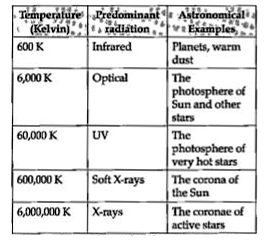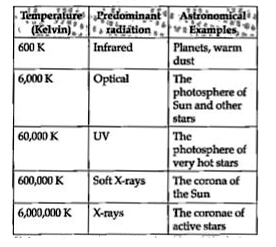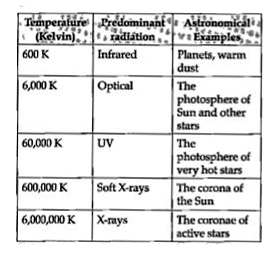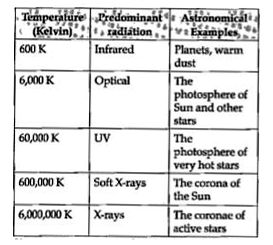Suppose we have made a model of the Solar system scaled down in the ratio η but of materials of the same mean density as the actual materials of the planets and the Sun. How will the orbital periods of revolution of planetary models change in this case?
The correct Answer is:[No Change]
Step by step video, text & image solution for Suppose we have made a model of the Solar system scaled down in the ratio eta but of materials of the same mean density as the actual materials of the planets and the Sun. How will the orbital periods of revolution of planetary models change in this case? by Physics experts to help you in doubts & scoring excellent marks in Class 11 exams.
Updated on:21/07/2023Topper's Solved these Questions
- GRAVITATIONBOOK - PHYSICS GALAXY - ASHISH ARORACHAPTER - GRAVITATIONEXERCISE - Discussion Qns
31 Videos
- GRAVITATIONBOOK - PHYSICS GALAXY - ASHISH ARORACHAPTER - GRAVITATIONEXERCISE - Concetual MCQ
39 Videos
- GRAVITATIONBOOK - PHYSICS GALAXY - ASHISH ARORACHAPTER - GRAVITATIONEXERCISE - Unsolved Numerical
94 Videos
- FLUID MECHANICSBOOK - PHYSICS GALAXY - ASHISH ARORACHAPTER - FLUID MECHANICSEXERCISE - Unsolved Numerical Problems
86 Videos
- KINEMATICSBOOK - PHYSICS GALAXY - ASHISH ARORACHAPTER - KINEMATICSEXERCISE - Unsolved Numerical Pro.
83 Videos
Similar Questions
In Rutherford's nuclear model of the atom, the nucleus (radius about 10−15m) is analogous to the sum about which the electron moves in orbit (radius about 10−10m) like the earth orbits around the sun. If the dimensions of the solar system had the same proportions as those of the atom, would the earth be closer to or further away form the sun than actually it is ? The radius of earth's orbit is about is 1.5×1011m. The radius of the sun is taken as 7×108m.
View SolutionRead the following text and answer the following questions on the basis of the same:
Spectrum Analysis and Astronomy
Each element in the periodic table can appear in gaseous form and produce its own spectrum unique to that element. Hydrogen will not look like Helium, which will not look like carbon which will not look like iron....and soon. Astrophysists can identify what kinds of materials are present in stars from the analysis of star's spectra. This type of study is called astronomical spectroscopy. The science of spectroscopy is quite sophisticated. From spectrum lines analysis astrophysists can determine not only the element, but the temperature and density of that element in the star. The spectral line also can tell us about any magnetic field of the star. The width of the line can tell us how fast the material is moving. We can learn about winds in stars from this. The shifting of spectral liens shift back and forth indicates that the star may be orbiting another star. The following table shows a rough guide for the relationship between the temperature of a star and the electromagnetic spectrum.

If the spectrum of a star is red or blue shifted, then it can be used to infer its velocity along the line of sight. Edwin Hubble observed that more distant galaxies tended to have more red shifted spectra. This establishes the theory of expansion of the universe.
Which nature of spectrum establishes the theory of the expanding universe?
View Solution
Knowledge Check
Read the following text and answer the following questions on the basis of the same:
Spectrum Analysis and Astronomy
Each element in the periodic table can appear in gaseous form and produce its own spectrum unique to that element. Hydrogen will not look like Helium, which wil not look like carbon which will not look like iron....and soon. Astrophysists can identify what kinds of materials are present in stars from the analysis of star's spectra. This type of study is called astronomical spectroscopy. The science of spectroscopy is quite sophisticated. From spectrum lines analysis astrophysists can determine not only the element, but the temperature and density of that element in the star. The spectral line also can tell us about any magnetic field of the star. The width of the line can tell us how fast the material is moving. We can learn about winds in stars from this. The shifting of spectral liens shift back and forth indicates that the star may be orbiting another star. The following table shows a rough guide for the relationship between the temperature of a star and the electromagnetic spectrum.

If the spectrum of a star is red or blue shifted, then it can be used to infer its velocity along the line of sight. Edwin Hubble observed that more distant galaxies tended to have more red shifted spectra. This establishes the theory of expansion of the universe.
From the spectrum analysis the following information of a star can be obtainedAElements present, temperatureBMagnetic field, density, massCdistance of the starDBoth A and BRead the following text and answer the following questions on the basis of the same:
Spectrum Analysis and Astronomy
Each element in the periodic table can appear in gaseous form and produce its own spectrum unique to that element. Hydrogen will not look like Helium, which will not look like carbon which will not look like iron....and soon. Astrophysists can identify what kinds of materials are present in stars from the analysis of star's spectra. This type of study is called astronomical spectroscopy. The science of spectroscopy is quite sophisticated. From spectrum lines analysis astrophysists can determine not only the element, but the temperature and density of that element in the star. The spectral line also can tell us about any magnetic field of the star. The width of the line can tell us how fast the material is moving. We can learn about winds in stars from this. The shifting of spectral liens shift back and forth indicates that the star may be orbiting another star. The following table shows a rough guide for the relationship between the temperature of a star and the electromagnetic spectrum.

If the spectrum of a star is red or blue shifted, then it can be used to infer its velocity along the line of sight. Edwin Hubble observed that more distant galaxies tended to have more red shifted spectra. This establishes the theory of expansion of the universe.
What is astronomical spectroscopy?AStudy of spectrum of star light and to identify its distance from Earth.BStudy spectrum of star light and to identify what kinds of elements are present in starsCBoth A and BDNone of the aboveRead the following text and answer the following questions on the basis of the same:
Spectrum Analysis and Astronomy
Each element in the periodic table can appear in gaseous form and produce its own spectrum unique to that element. Hydrogen will not look like Helium, which wil not look like carbon which will not look like iron....and soon. Astrophysists can identify what kinds of materials are present in stars from the analysis of star's spectra. This type of study is called astronomical spectroscopy. The science of spectroscopy is quite sophisticated. From spectrum lines analysis astrophysists can determine not only the element, but the temperature and density of that element in the star. The spectral line also can tell us about any magnetic field of the star. The width of the line can tell us how fast the material is moving. We can learn about winds in stars from this. The shifting of spectral liens shift back and forth indicates that the star may be orbiting another star. The following table shows a rough guide for the relationship between the temperature of a star and the electromagnetic spectrum.

If the spectrum of a star is red or blue shifted, then it can be used to infer its velocity along the line of sight. Edwin Hubble observed that more distant galaxies tended to have more red shifted spectra. This establishes the theory of expansion of the universe.
What may be the approximate temperature if soft X-rays are found predominantly in the spectrum?A60000CB600000CC60000KD600000K
Read the following text and answer the following questions on the basis of the same:
Spectrum Analysis and Astronomy
Each element in the periodic table can appear in gaseous form and produce its own spectrum unique to that element. Hydrogen will not look like Helium, which will not look like carbon which will not look like iron....and soon. Astrophysists can identify what kinds of materials are present in stars from the analysis of star's spectra. This type of study is called astronomical spectroscopy. The science of spectroscopy is quite sophisticated. From spectrum lines analysis astrophysists can determine not only the element, but the temperature and density of that element in the star. The spectral line also can tell us about any magnetic field of the star. The width of the line can tell us how fast the material is moving. We can learn about winds in stars from this. The shifting of spectral liens shift back and forth indicates that the star may be orbiting another star. The following table shows a rough guide for the relationship between the temperature of a star and the electromagnetic spectrum.

If the spectrum of a star is red or blue shifted, then it can be used to infer its velocity along the line of sight. Edwin Hubble observed that more distant galaxies tended to have more red shifted spectra. This establishes the theory of expansion of the universe.
The lines in a star's spectrum is found to shift back and forth. What conclusion may be drawn from this observation?
View SolutionThe motion of a planet around sun in an elliptical orbit is shown in the following figure. Sun is situated at one focus. The shaded areas are equal. If the planet takes time t1 and l2 in moving from A to B and from C to D respectively, then

View SolutionThe motion of a planet around sun in an elliptical orbit is shown in the following figure. Sun is situated at one focus. The shaded areas are equal. If the planet takes time t1 and l2 in moving from A to B and from C to D respectively, then

View SolutionAstronomers observe two separate solar systems each consisting of a planet orbiting a sun. The two orbits are circular and have the same radius R. It is determined that the planets have angular momenta of the same magnitude L about their suns, and that the orbital periods are in the ratio of three to one, i.e. T1=3T2. The ratio m1/m2 of the masses of the two planets is
View SolutionRead the passage carefully and select the best answer to each question out of the given four alternatives.
The quest to find life outside the solar system got a big boost with the discovery of seven Earth-size extra-solar planets, or exoplanets, orbiting a dwarf star about 40 light years away. Unlike earlier discoveries of exoplanets, all seven planets could possibly have liquid water - a key to life, as we know it on Earth - with three planets having the greatest chance. This is by far the largest collection of Earth-like planets in the habitable .Goldilocks. zone of a star- neither too close nor too far from a star, which raises the possibility of liquid water being present on the surface. Only Earth has liquid water in the solar system. Since the dwarf star is much cooler than the Sun, the dimming of light each time a planet passes or transits before the star could be easily recorded from Earth unlike in cases when planets transit a Sun-like bright star. Since the initial discovery of three planets was made using the Chile-based Transiting Planets and Planetesimals Small Telescope, the exoplanet system is called TRAPPIST-1.
How many planets in our solar system have liquid water?
View Solution
